Are you a parent who loves to write? Do you have advice and stories to share with other parents? Are you looking for a way to make some extra money online?
If yes, starting a parenting blog could be the perfect way to share your wisdom, connect with other parents and make money online.
In this post, we’ll show you how to start a parenting blog and make money online in 2025. We will also share some tips to make money from your parenting blog.
So read on to learn more.

How to Start a Parenting Blog in 7 Steps
- Define Your Parenting Blogging Goals
- Choose a Parenting Niche
- Pick & Register a Blog Domain Name
- Setup WordPress
- Write & Publish Blog Posts
- Promote Your Parenting Blog
- Monetize & Make Money
1. Define Your Parenting Blogging Goals
As a parent, you have valuable insights and experiences to share with other parents who are walking the same journey. By starting a parenting blog, you can help other parents while also building an online business.
But before you start blogging, it’s important to define your goals.
Why do you want to start a blog?
What kind of impact do you want to make?
What type of content will you publish?
Answering these questions will help you create a focused and successful parenting blog.
Are you a stay-at-home mom who wants to start a mom blog? If you are an aspiring mom blogger, we have a dedicated guide for mom bloggers called how to start a mom blog.
What is a Parenting Blog?
A parenting blog is a platform where parents can read stories, advice, and insights about parenting. Parenting blogs cover a wide range of topics, from pregnancy and childbirth to discipline and potty training.
Why Start a Parenting Blog?
There are many reasons to start a parenting blog. Maybe you want to help other parents by sharing your experiences. Or maybe you’re looking for a creative outlet outside of parenting.
Whatever your reasons, starting a parenting blog can be a rewarding experience. Here are some benefits of starting a parenting blog:
- Share Your Parenting Journey: A parenting blog is a great way to share your journey with other parents. By sharing your stories and advice, you can help others who are facing similar challenges.
- Build an Online Business: A successful parenting blog can be turned into a profitable online business. There are many ways to make money from a parenting blog, including advertising, affiliate marketing, and selling digital products.
- Expand Your Community: By starting a parenting blog, you can connect with other parents and build a supportive online community.
- Become an Influencer: A popular parenting blog can help you build your brand and become an influencer in the parenting space.
How much money can you make from parenting blogging?
You can make $15-$25 for every 1000 ad views on your parenting blog. An SEO optimized blog post can get anywhere between 300 to 1000 visits per month. So, a parenting blog with 100 blog posts can make as high as $2500 every month. You can make even more money if you monetize with affiliate marketing and digital products.
2. Choose a Parenting Niche
When starting a parenting blog, it’s important to choose a blog niche. A niche is a specific blog topic that you’ll write about on your blog.
For example, if you’re a stay-at-home mom, you might choose to write about frugal living for families. Or if you’re a working mom, you might write about time management for working moms.
Why choose a niche?
There are many benefits to choosing a parenting niche for your blog.
- Focus Your Content: A parenting niche helps you focus your content and create a more targeted audience.
- Better Engagement: By writing about a specific topic, you’ll be able to connect with other parents who share similar interests and experiences. This will lead to better engagement with your audience.
- Increased Opportunities: A well-defined niche opens up opportunities for partnerships, sponsorships, and product collaborations.
- Improved SEO: When you write about a specific topic, it’s easier to optimize your content for SEO. This will help you attract more organic traffic to your blog.
- Increased Expertise: Writing about a specific topic will help you become an expert in that area.
Finding Your Ideal Niche
There are many parenting niches to choose from, and it’s important to choose one that you’re passionate about. By writing about a topic that you’re interested in, you’ll be able to create content that is informative and engaging.

There are many ways to find a parenting niche for your blog. Here are some tips:
- Write Down Your Interests: The first step is to make a list of your interests. What topics do you enjoy writing about? What are you passionate about?
- Identify Your Experiences: What experiences do you have that other parents might be interested in? For example, if you’re a working mom, you might write about how to balance work and parenting.
- Research Your Competition: Once you’ve identified some potential niches, it’s time to research your competition. Look at other parenting blogs and see what topics they’re writing about. This will help you narrow down your niche and find a unique angle for your blog.
Here are a few parenting niches to help you find yours:
- Working Mom
- Co-Parenting
- Pregnancy and Childbirth
- Child Development
- Parenting Styles and Tips
- Family Travel
- Frugal Living for Families
- Food and Nutrition for Kids
- Homesteading with Kids
- Stay-at-Home Mom
- Online Parenting Communities
- Children’s Literature and Creativity
Find a few niches that you have passion, interest, and expertise in.
Examples of Parenting Blog
Sometimes looking at other parenting blogs will help inspire ideas of your own. Here are some of the more popular examples of parenting blogs:
1. Thoughtful Parent
This is a blog that covers parenting topics including child development, parent coaching, and social-emotional development.
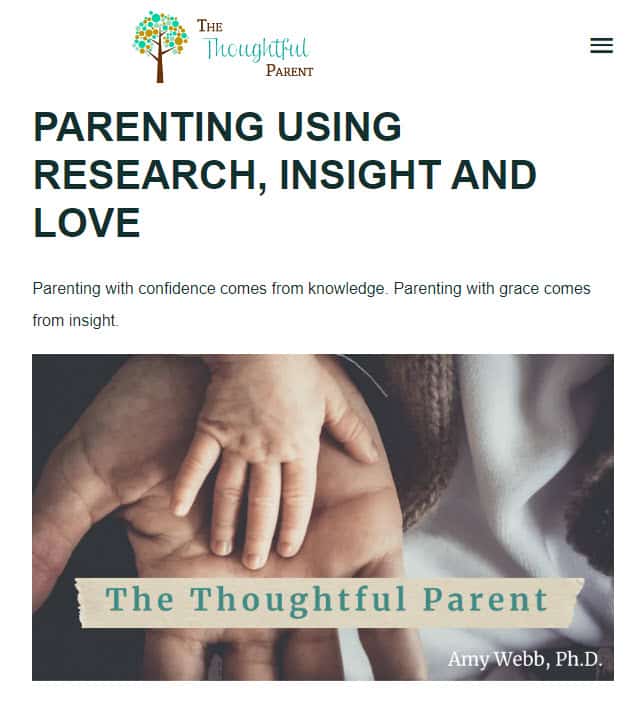
2. Life of Dad
In a world filled with mom blogs, there aren’t that many blogs that focus on fathers. This is a blog and podcast that focuses on fathers and fatherhood.

3. Pregnant Chicken
This blog covers all aspects of pregnancy. It covers getting pregnant, being pregnant, labor & delivery, postpartum, and babyhood.
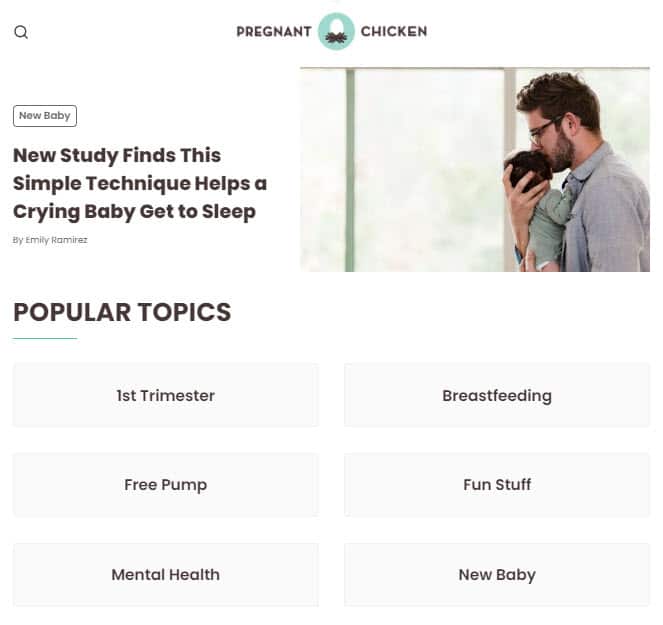
4. Plus Size Birth
This blog is a great example of choosing a niche. It focuses on pregnancy and childbirth for plus-size women.

3. Pick & Register a Blog Domain Name
Once you have chosen your niche, it is time to brainstorm a few names for your parenting blog.
We recommend you keep your parenting blog’s name to two words (Example: Pregnant Chicken). One of the two words should be a keyword from your niche. The other word can be something that makes your website brandable. For example, our blog teaches people how to make passive income, so we have named it Passive Book.
Here are some of the words that you can mix and match into your blog name:
- Parent
- Parenting
- Parents
- Kids
- Mom
- Mum
- Mother
- Mommy
- Dad
- Father
- Family
- Pregnant
- Baby
Use a Business Name Generator to brainstorm the name of your blog.

You can also use your own name for your blog. But if you ever plan to sell your website in the future, it is much more difficult to transfer your brand to the buyer when it is your name.
Check Domain Name Availability
After you have brainstormed a few names for your parenting blog, you should check if the .com domain name is available.
A domain name is the web address that people type into their browsers to visit your parenting blog. It is usually your parenting blog’s name followed by .com. For example, the domain name of this website is passivebook.com.
You must check if both the .com domain name and the social media handles are available. You can use Namechk to check the availability of both your domain name and social media handles.
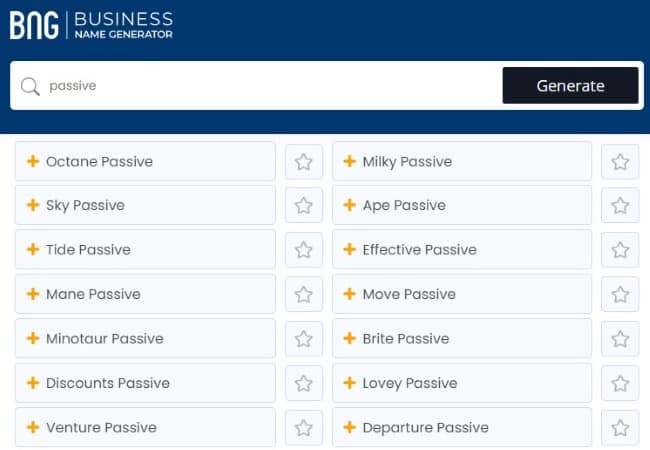
Here are a few things to keep in mind when selecting a domain name:
- Choose a .com domain name. 86% of the internet uses .com, so your visitors are likely to try visiting your blog by typing .com. Avoid other extensions like .net or .org.
- Don’t include hyphens and numbers.
- Do not use words with multiple spellings (for example colour vs color).
- Shorter domain names are better. Try to keep it under 12 characters.
- Spelling & Pronunciation should be easy and intuitive.
- It should be easy to remember.
- Avoid words that can be misread together. For example, therapistjohn.com can be read as Therapist John or The Rapist John.
- Make sure it’s not trademarked or copyrighted by someone else. The AI writing software Jarvis.ai had to rebrand to Jasper.ai because Marvel sued them for the Iron Man reference. Lawsuits will happen once your blog is established.

Register a Domain Name
Once you decide your domain name it is time to register it.
You should register your domain with NameCheap because you will get domain privacy for free. Other providers charge $12 per year for domain privacy. Without domain privacy, your name, home & email address will be accessible to the public.
Step 1: Go to NameCheap. Enter your domain name with the .com extension.

Step 2: Select the .com extension and click the Add to Cart button.
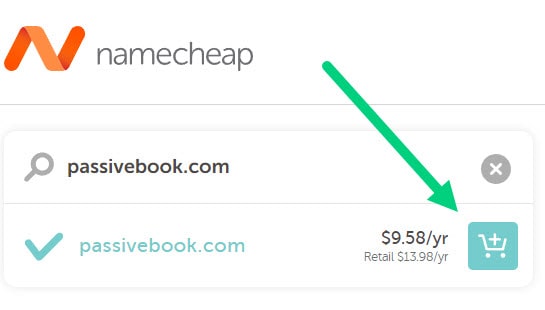
Step 3: After adding the domain to the cart, click on the Checkout button.
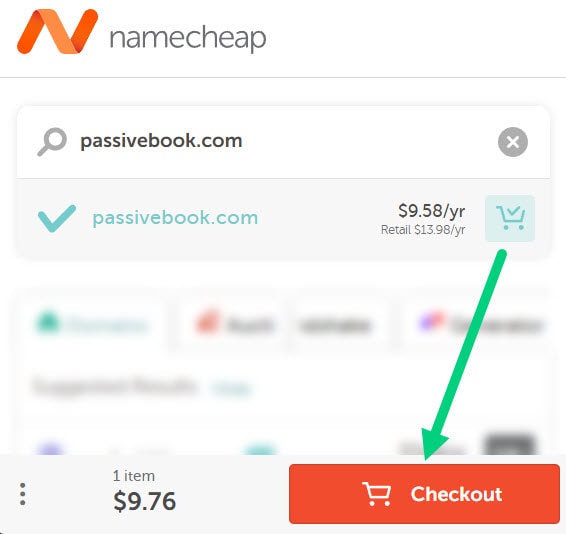
Step 4: Enable Domain Privacy that comes for free along with auto-renew. You don’t need any other paid addon.
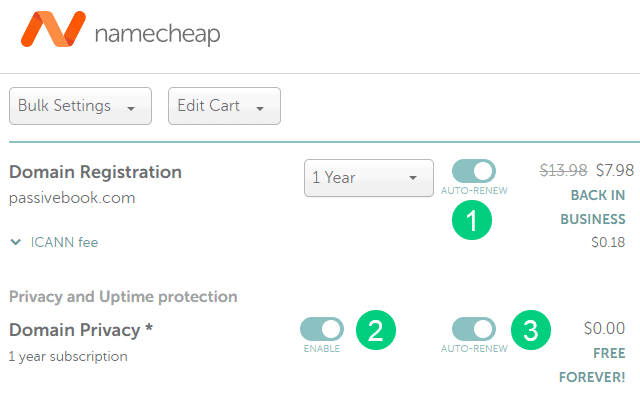
Step 5: Click on Confirm Order. Pay to complete your purchase.
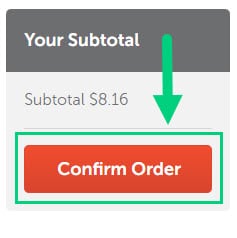
Step 6: Log in to Namecheap and click on Domain List ❶ in the left sidebar and then click Manage ❷ next to the domain you just purchased.
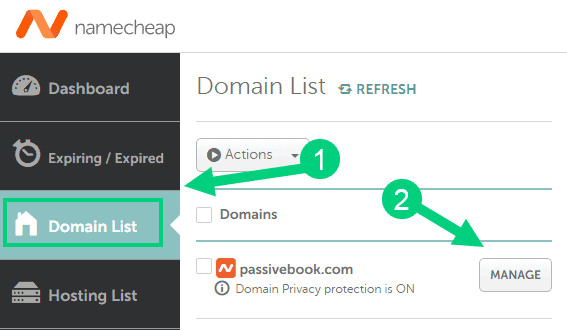
Step 7: Under the Nameservers section, select “Custom DNS” from the dropdown ❶. Then enter the following two nameservers ❷ ns1.bluehost.com and ns2.bluehost.com as shown in the image. Then click the green tick ❸ to save. If you use a hosting provider other than Bluehost, enter their nameserver values in this step instead.
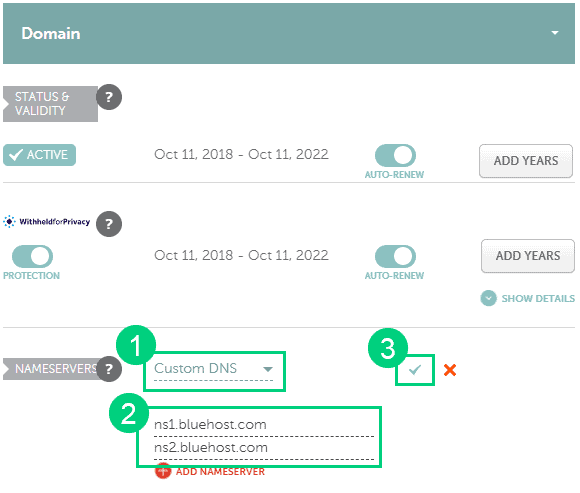
Can I get a free domain name?
Your web hosting provider might give you a free domain name for one year but they charge $12 for domain privacy which is free in Namecheap. From the second year, you will pay for both the domain and privacy which will cost you more than $20+. So it is cheaper to just register your domain with Namecheap from the beginning. Also using different companies for web hosting and domain registration will allow you to easily switch your blog host later without transferring domains.
Can I change the name of my blog later?
You will lose your search engine rankings if you change your blog’s name once it gets links from other websites. It will take as long as a year or more for you to regain the lost traffic. It is possible to mitigate problems by having proper redirects. But you will have to renew both your old and new domains every year. So try to avoid changing your blog’s name once it is established.
4. Setup WordPress
The next step is to get your blog up and running in WordPress.
WordPress is a content management system (CMS) that makes it easy to create a parenting blog from scratch without learning how to code.
Why Choose WordPress.org?
There are many blogging platforms but the self-hosted wordpress.org powers 70% of blogs on the internet. 42% of all websites on the internet use WordPress.
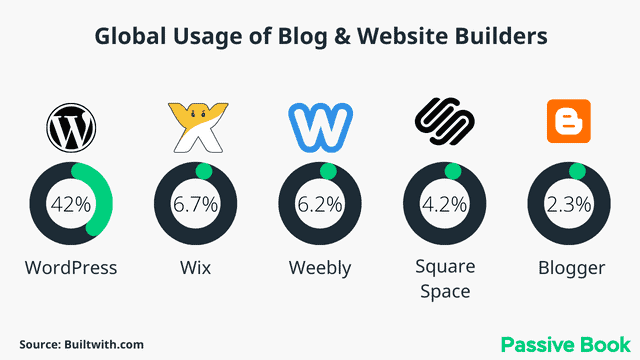
WordPress.org is completely free and open-source software released under the GPL.
It provides a wide range of themes and plugins to customize the look and extend the functionality of your parenting blog.
You will have complete control over how you monetize your parenting blog as there are no rules and regulations like the other platforms.
WordPress.org vs WordPress.com
Do not confuse WordPress.org with WordPress.com.
WordPress.com is a for-profit company owned by Automattic Inc that provides hosting, themes, and plugins for WordPress websites.
While it’s easy to get started with WordPress.com, you will be limited in how you can monetize your parenting blog as they do not allow any advertisements or affiliate links.
You will also have to pay them a monthly fee if you want to use a custom domain name or remove their branding from your blog.
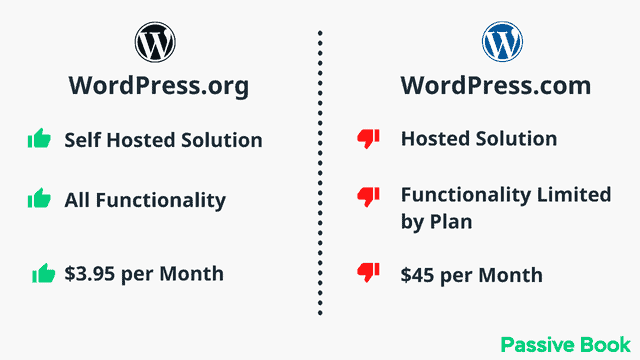
I do not recommend using WordPress.com for your parenting blog as it is not a good long-term solution if you ever want to make money blogging.
Why Avoid Free Blogging Platforms
There are many free blogging platforms available such as Blogger, Wix, and Medium. While they might be tempting to use because they’re free, I do not recommend using any of these platforms for your parenting blog.
You will be limited in how you can customize the look and feel of your blog as you will be restricted to using the themes and plugins provided by the platform.
You will also have to put up with their branding on your blog and might even have your website taken down if you violate their terms of service. There are instances of thousands of horror stories of bloggers and Tumblr blogs being deleted overnight without warning.

If you’re serious about blogging, then you should avoid using any free blogging platforms.
What to do if you already have a free blog?
Migrating to WordPress is a simple process with the help of import plugins. There are a number of WordPress import plugins available that make it easy to move your content from one platform to another. All you need is a import plugin, an internet connection, and a few minutes to export your content.
How much does it cost to start a parenting blog?
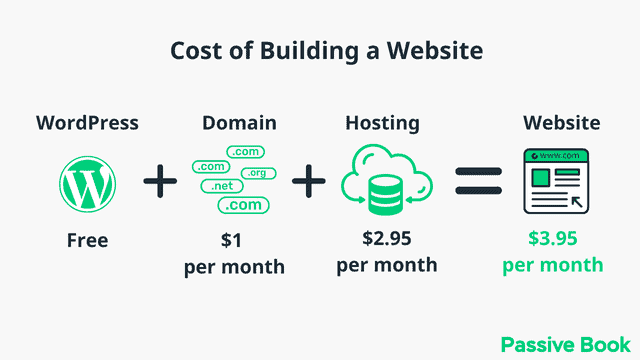
It will cost you $2.95 per month to host your WordPress parenting blog in Bluehost. A domain will cost you $12/year. So that is a total of $4.2 per month, which is less than the price of Netflix for all the unlimited features that a self-hosted WordPress blog has to offer.
Install WordPress in Hosting
Before you can install WordPress and set up your parenting blog, you need to get your hosting set up.
Hosting is a service that provides the server space to store the blog posts, files, and images of your parenting blog.
When someone visits your parenting blog in a browser like Chrome or Firefox, your web host will load files from their server into your visitor’s browser, allowing them to access your parenting blog.
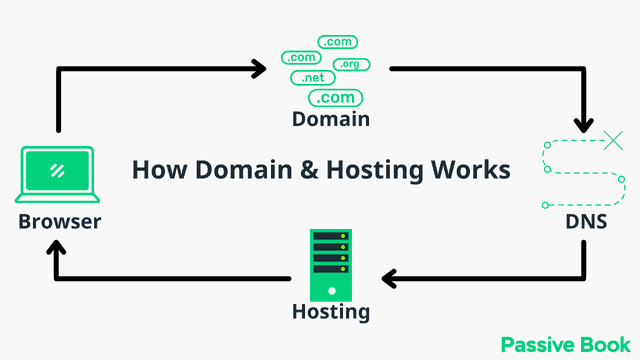
For this guide, we will use BlueHost as our web host. It is a cheap hosting that is extremely easy for beginners to set up. If you use any other web host, the steps will be the same but the user interface may be slightly different.
1. Go to BlueHost using this link to get a special discount. Select WordPress > WordPress Hosting from the top menu.
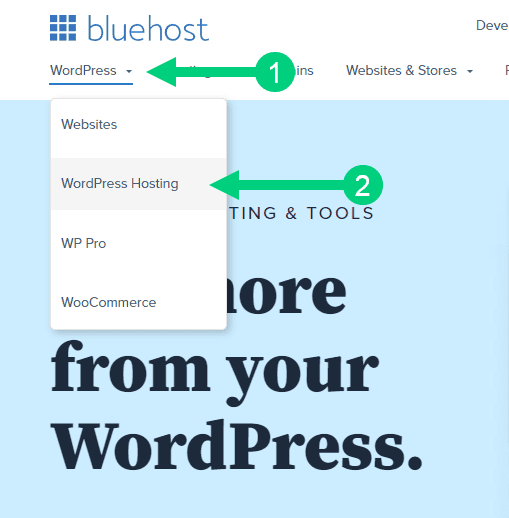
2. Click on the button you see on this page and you will be taken to the pricing section.
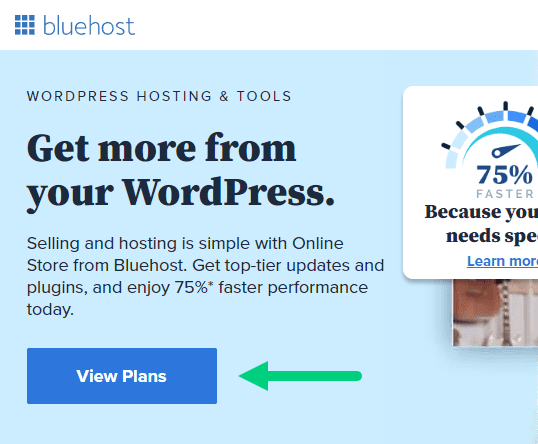
3. Select the Basic Plan. You can upgrade to a different hosting plan as you grow.

4. If you already have a domain name that you purchased with Namecheap you can put that in the “Use a domain you own” ❶ section. If you don’t have a domain name yet, choose the “Create a New Domain” ❷ to purchase a new domain.
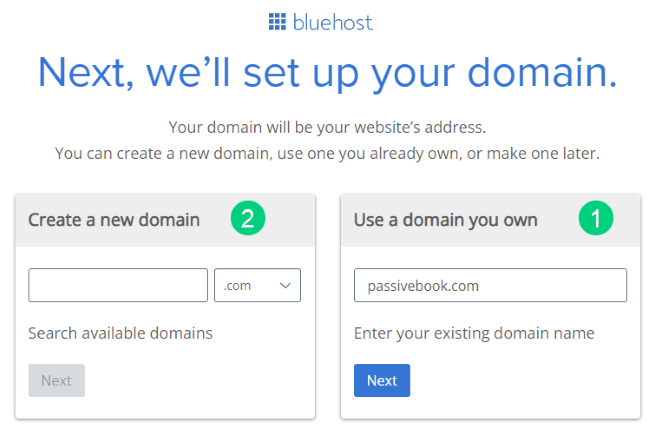
5. In the next screen, enter your information. Uncheck all package extras. If you purchase your domain through Bluehost instead of Namecheap, you may want to enable Domain Privacy. You won’t see the Domain Privacy option if you bought your domain through Namecheap. Namecheap will give you this Domain Privacy for free.
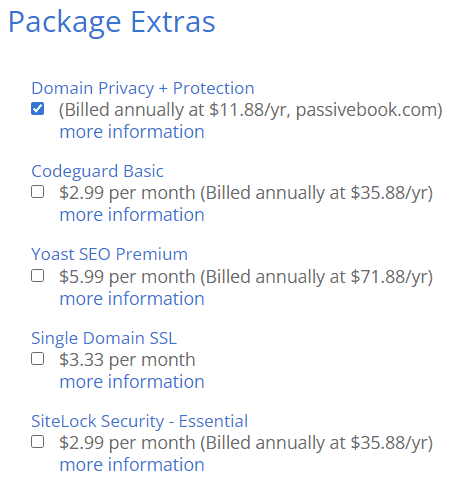
6. Once you have successfully paid, you will be prompted to set a password. Click on the “Create your Password” button.
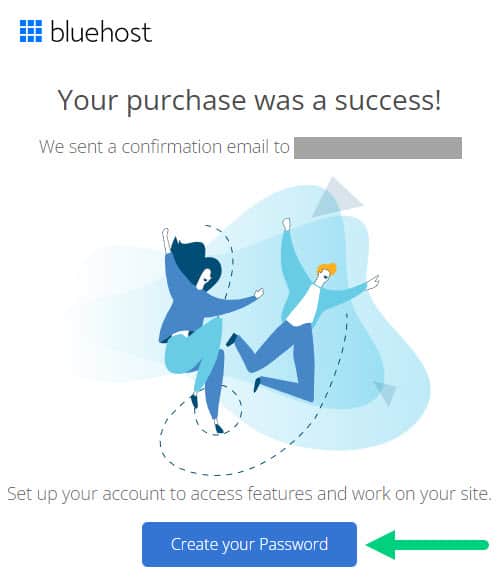
7. Enter your password and create your account. If you lose this password, you can reset it.
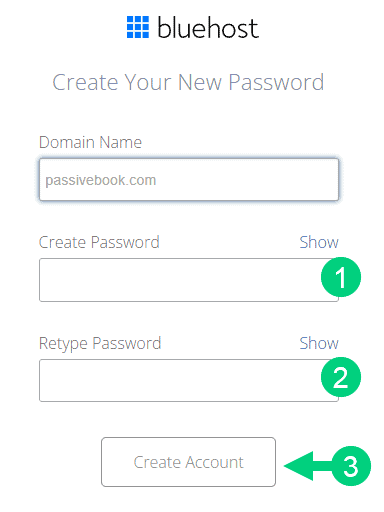
8. After you set your password, log in to Bluehost.
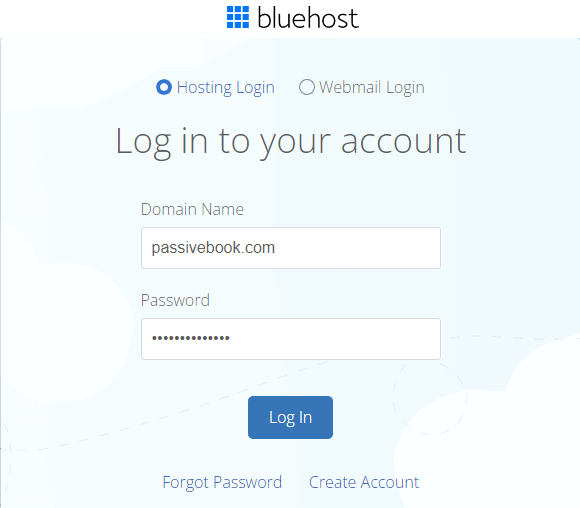
9. Click on the Create your website button on the following screen. This will start a Bluehost Wizard, just click Skip this step wherever possible.

10. On the following page, click “No help needed” or “Skip this step”. We don’t want Bluehost to limit our customization options.
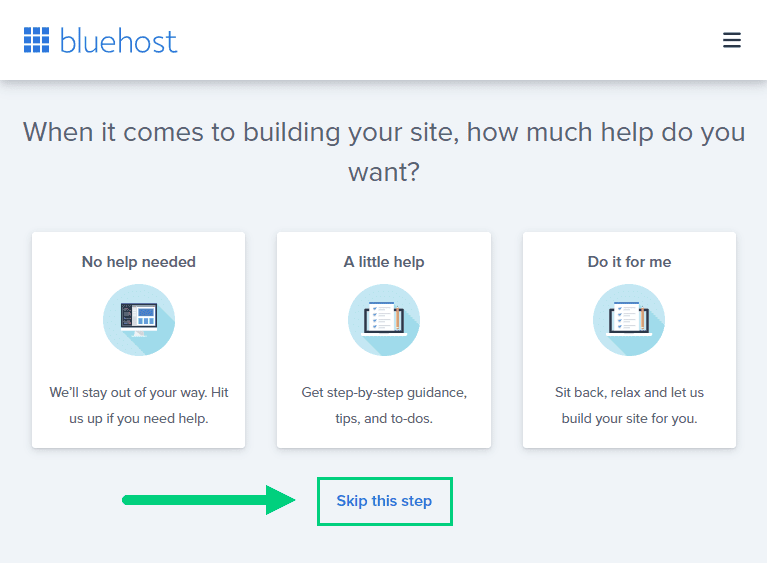
11. On the next page, you will be asked about the purpose of your website. You can choose from any of the available options.
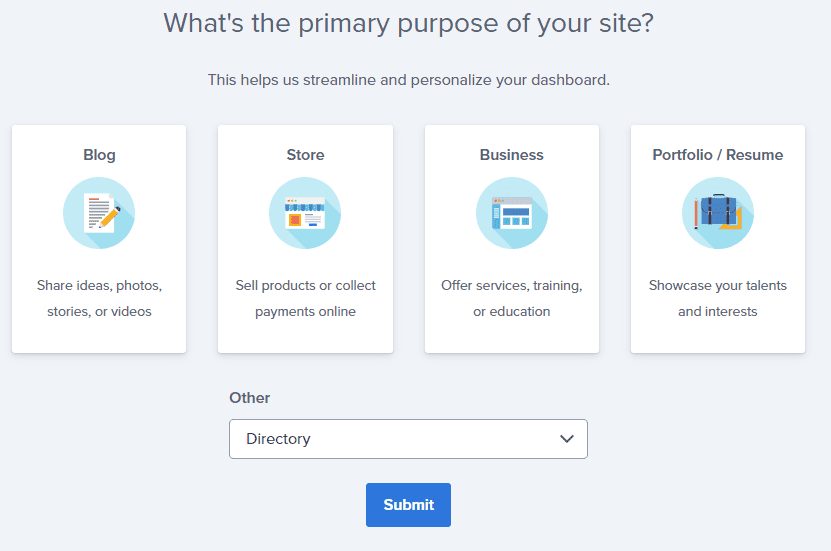
12. On the next page, click Skip this step.

13. On the following page, enter the blog’s name and tagline. You can change this later so feel free to click “Skip this step” or enter something as a placeholder and click Continue.
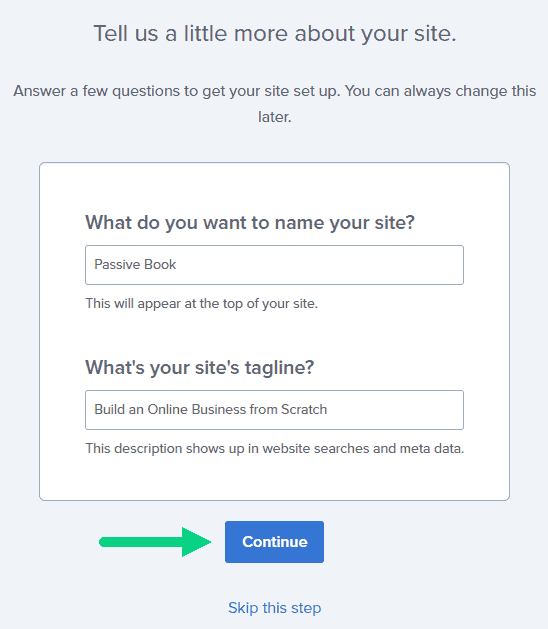
14. Finally you will be asked how you want to build your website. Choose “Limitless customization” to have all the options.

15. You can see your blog by going to yourdomain.com. Go to the Bluehost dashboard and click on the My Sites tab ❶ in the left sidebar and click on the “Manage site” button ❷.
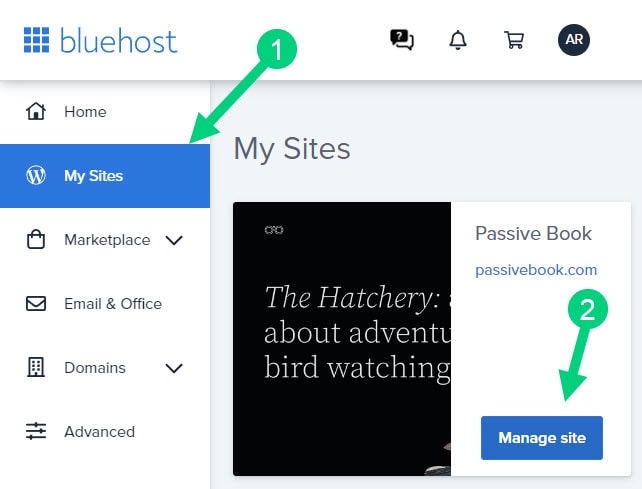
16. Your WordPress site has separate login credentials different from the ones you use to log into Bluehost. You can use this to log in to the WordPress dashboard directly without logging into Bluehost. To get this:
❶ Click on Users on top.
❷ You will be able to see your username and email that you can use to log in to WordPress.
❸ If you click on the three dots you will see the option to Reset your password. ❹
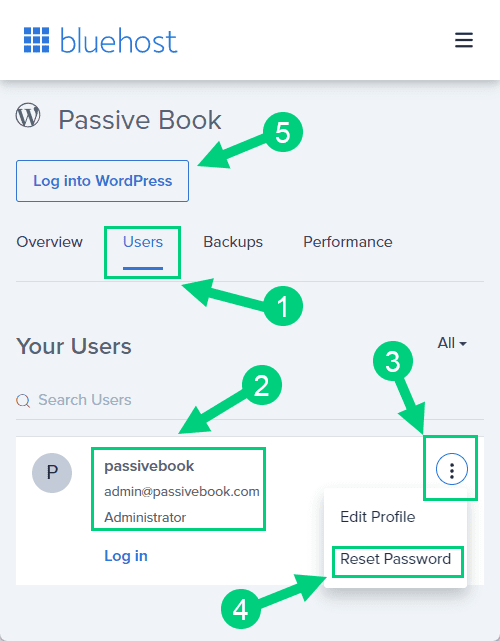
You can log into WordPress from the Bluehost dashboard by clicking the Log in to WordPress button ❺. But it is not recommended you rely on this as your primary login method because you will get locked out of your site if you ever change hosting providers.
17. You will be taken to the WordPress dashboard where you can reset your password ❶. If you don’t like the username Bluehost created for you, you can Add a New User ❷.

18. If you are adding a new user make sure you specify the user role as Administrator ❶. You can log in as the new user and safely delete the default user created by Bluehost.

Congratulations! You have successfully set up WordPress.
Configure WordPress
Now that you have the basic version of WordPress installed, it is time to customize it to make it look and feel the way you want.
Login to WordPress Dashboard
The WordPress Dashboard is the control center for your parenting blog. It provides an overview of all the activity taking place on your blog and allows you to manage your blog settings, posts, pages, comments, users, and more.
Visit yourdomain.com/wp-admin to access the WordPress dashboard.
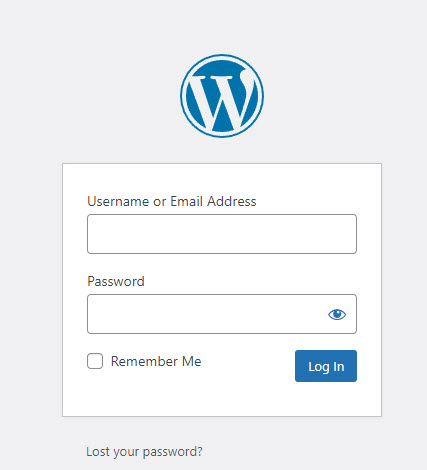
Use the Email and Password you provided during installation to log in to your WordPress dashboard. If you don’t have a password, use the “Lost your password?” to generate a new password.
Install WP Themes
A WordPress Theme is a collection of files that determine the look and feel of your parenting blog. When you install a WordPress theme, it will change the entire design of your blog including the fonts, colors, layout, and more.
Your new WordPress blog will be installed with a default blog theme that doesn’t look very great.
To install a new WordPress Theme:
Go to Appearance > Themes > Add New in your WordPress dashboard.
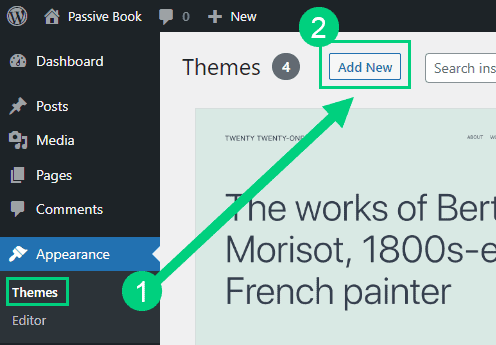
Use the search to find a theme that you like ❶. Before you install the theme, you can see a demo of the theme and learn about its features from the preview screen ❷. If you like the theme, you can install it by clicking the install button ❸. You can also upload a theme from a file on your computer ❹.

Once installed, click the Activate button to enable the theme.
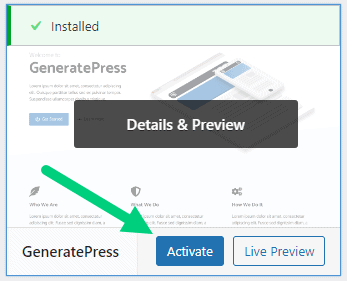
Although you can use a free theme (there are thousands of free themes available), we recommend using a premium theme.
Premium themes not only reduce your website’s load time but also help you customize your website to your heart’s desire.
Here are the premium themes we recommend:
There are also several custom-made parenting blog themes. These themes tend to be bloated with poor code which will slow down the performance of your website. We suggest getting one of our recommended themes for a fast website with unlimited customization possibilities.
Install WP Plugins
WordPress Plugins are tools that allow you to add additional functionality to your WordPress website. There are plugins for just about anything including SEO, social media, contact forms, and more.
Too many wordpress plugins can slow down your blog site. So before you install new plugins, it will be worth clearing out any existing plugins that your hosting provider installed by default.
Plugins first need to be deactivated before they can be deleted.
❶ Go to WP Admin > Plugins > Installed Plugins
❷ Click on the checkbox to select all plugins.
❸ Select Deactivate from the drop-down.
❹ Click Apply.
❺ Repeat the above steps but select “Delete” instead of “Deactivate” from the dropdown in ❸ to delete all the deactivated plugins.
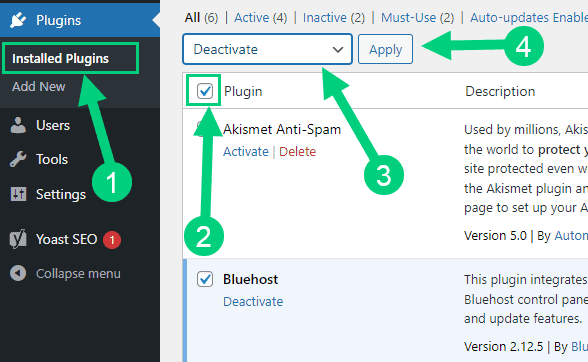
To install new plugins go to the WP Admin > Plugins > Add New.

On the plugins page:
❶ Search for the plugin you want in the search bar
❷ Click Install Now. Once you install the plugin, you must also activate the plugin for it to be enabled.
❸ If you are installing a paid plugin you can upload the plugin instead.
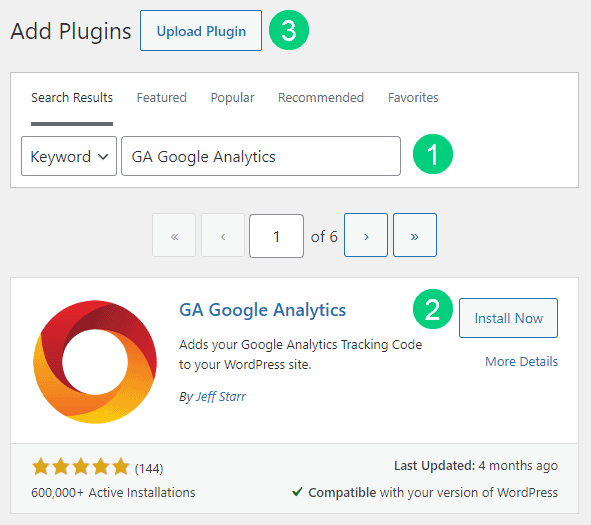
There are many different parenting blog plugins that you can install, but here are the ones which we recommend:
Backup Plugin: A WordPress Backup Plugin allows you to create backups of your WordPress website. This is important because if something goes wrong with your website, you can use the backup to restore your website to the last known good state.
Recommended Plugin: WPVivid (paid) or UpdraftPlus (free).
SEO Plugin: WordPress SEO Plugins improve the search engine visibility of your parenting blog.
Recommended Plugin: RankMath Pro (paid).
Google Analytics Plugin: A WordPress Google Analytics Plugin lets you to collect data about your website traffic and activity. This data can then be used to improve the performance of your website.
Recommended Plugin: RankMath Pro (paid) or GA Google Analytics (free).
Cache Plugin: A WordPress Cache Plugin stores a copy of your website’s data in a temporary location. This can improve the performance of your website because it will allow your website to load faster for your visitors.
Recommended Plugin: WP Rocket (paid).
Page Builder Plugin: A WordPress Page Builder Plugin allows you to create custom pages for your parenting blog. You can create unique pages that match the look and feel of your blog.
Recommended Plugin: Thrive Architect (paid).
Security Plugin: A WordPress Security Plugin protects your WordPress website from hackers and other threats.
Recommended Plugin: Wordfence (free).
Social Media Plugin: A WordPress Social Share Plugin lets you to share your blog posts on social media websites. Your readers can share your content with their friends and followers.
Recommended Plugin: Easy Social Share Buttons (paid).
Email List & Lead Generation Plugin: A WordPress Email Opt-in Form Plugin helps you to collect email addresses from your website visitors. You can build a list of email subscribers who are interested in your parenting blog.
Recommended Plugin: Thrive Leads (paid).
Customize WordPress
Once you have installed your theme and plugins, it is time to customize the wordpress blog platform:
Change Colors, Fonts & Spacing
You can set the font, colors, and spacing by going to Appearance > Customize in your WordPress dashboard. Premium themes like GeneratePress allow you to customize every aspect of your blog.
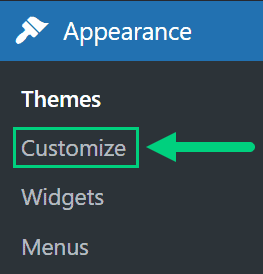
Check out our Blog Fonts & Typography guide to choose the right font and typography settings for your blog.
Add Your Logo
Get a logo designed for your blog from Fiverr. Then set the logo of your blog by going to Appearance > Customize in your WordPress dashboard. A logo is not required for a successful blog but it can definitely help appeal to your target audience.
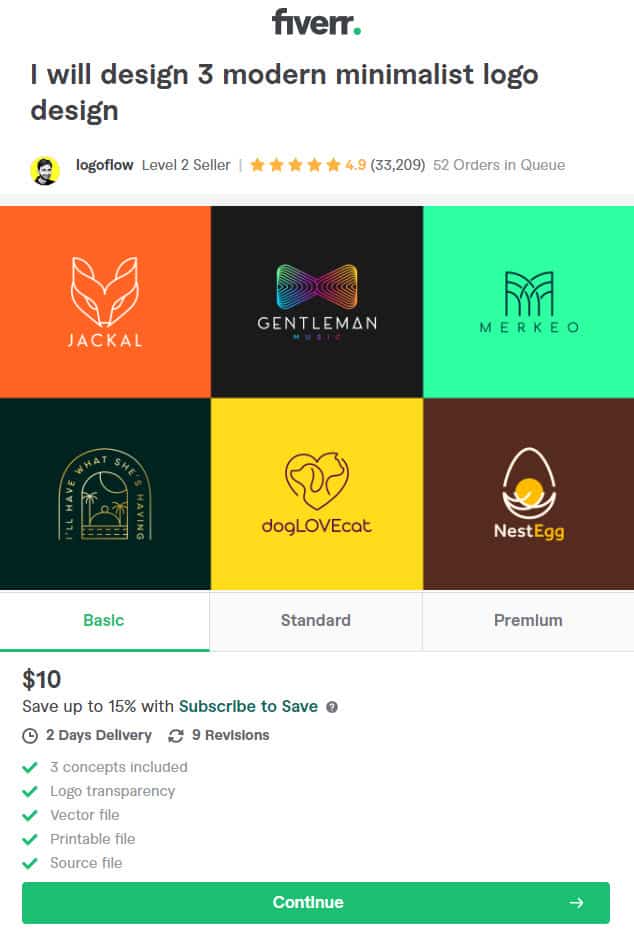
Change Favicon
Favicon is the image that appears in the browser tab and bookmarks. Set the Favicon from the Appearance > Customize section of the WordPress dashboard.

Create Menus
The header and the footer menu can be set from the Appearance > Menus in your WordPress blog dashboard.

You can nest menu items so that it appears as a dropdown menu ❶. You can use the menu as your primary or secondary navigation menu ❷. Don’t forget to save your menu ❸.
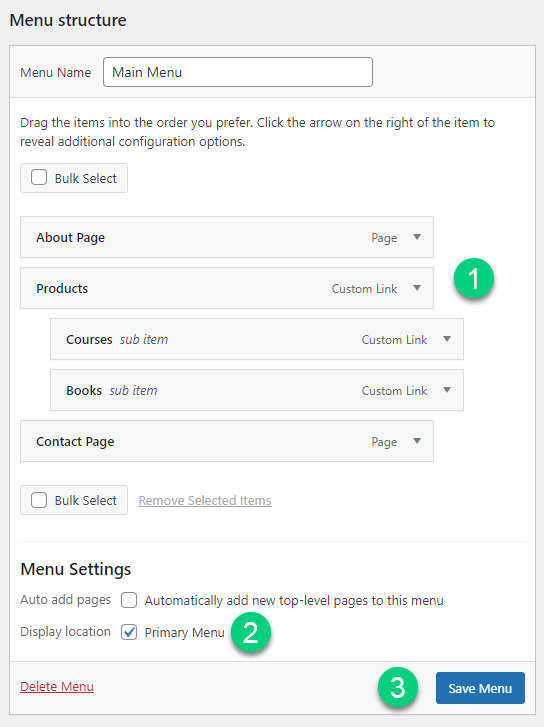
Create Widgets
If you have a sidebar, you can add widgets to it. Go to Appearance > Widgets in your WordPress admin dashboard.
Check out the list of the most useful Blog Widgets and how to add them to your blog.

Set Title & Tag Line
The next step is to change your General Settings. Go to Settings > General in the WordPress Admin area.
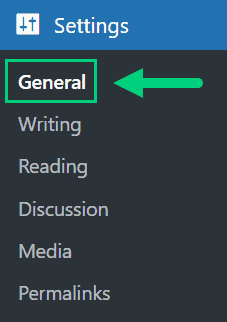
You can set your Site Title, Tagline, and Time Zone from this screen.
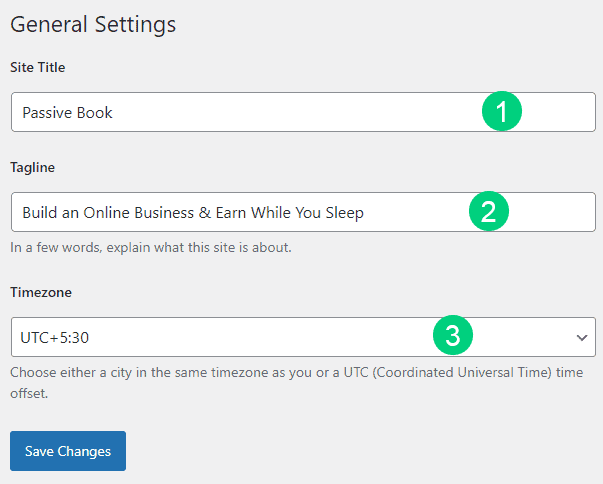
Set Permalinks
The ideal URL structure for SEO is yourdomain.com/sample-post. Set your permalink structure by going to Settings > Permalinks in your WordPress blog dashboard.

Select the “Post name” radio button and save changes.
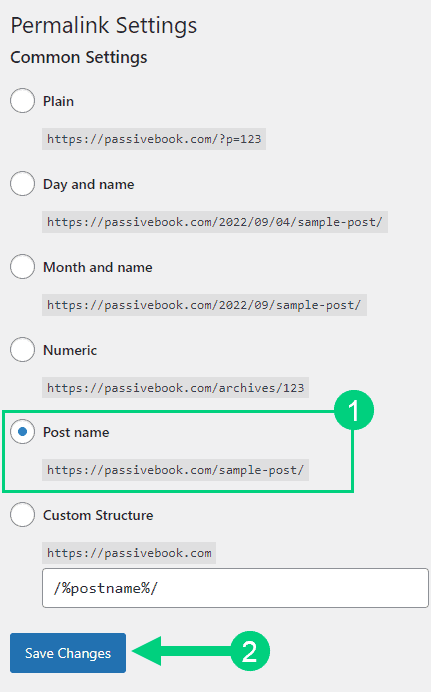
Enable Search Visibility
Chances are you want your blog to show up on Google so people can find you. Go to Settings > Reading in your WordPress dashboard.
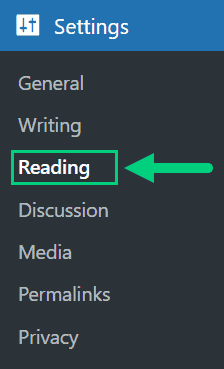
To get search engine traffic, ensure the checkbox “Disable search engines from indexing this site” is Unchecked. You can find this option in Settings > Reading. Most of the time this should be unchecked by default but if it is not, then uncheck it to ensure your site gets traffic from search engines.
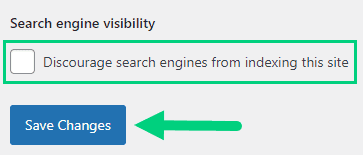
Adjust Comment Settings
Next, you will want to change the Discussion Setting (aka Comments). Go to Settings > Discussion in your WordPress admin area.
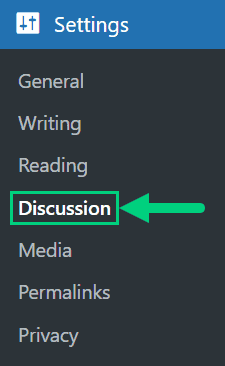
❶ You may want to enable or disable comments on this page. You can also disable pingbacks and enable comment moderation.
❷ You can also set comment approval settings.
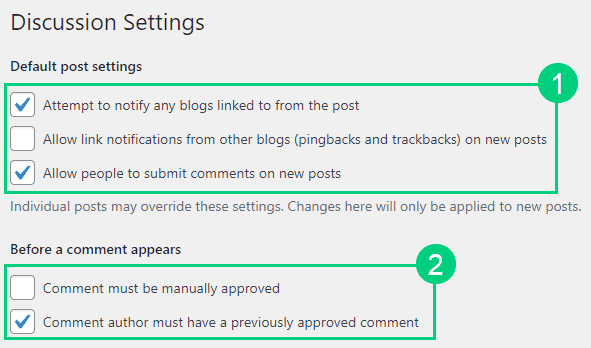
If you want to design your blog further, check out our dedicated guide on blog design which has all our best blog design recommendations.
Create Static Pages
There are a few essential pages that you need to create for your parenting blog before you can start blogging.
Use pages in WordPress to add static content. Go to WP Dashboard > Pages > Add New.
- Write the headline of your content.
- Populate the body content
- Click the publish button.

You may want to create the following pages:
Home Page
A home page is the main page of your website. It is the first page that your visitors see when they visit your website. The home page typically contains a welcome message, along with a list of your latest blog posts.
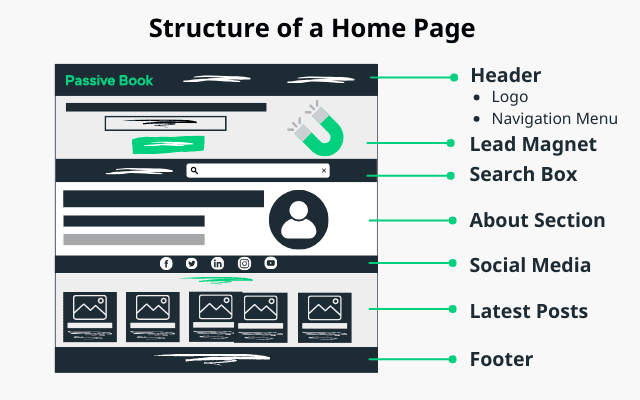
You can create a professional home page for your parenting blog using a page builder like Thrive Architect.
About Page
An about page is a page that tells your visitors who you are and what your blog is about. The About page is one of the most important pages on your website because it allows your visitors to get to know you and learn more about your blog.
An about page should include the following information:
- Who you are
- What your blog is about
- Why you started a parenting blog
- Who your blog is for
- What you hope to achieve with your parenting blog

Contact Page
A contact page is a page that allows your visitors to contact you. The contact page should include your email address and a form that your visitors can use to send you a message.
Use contact form plugins like Fluent Forms to create the form on your contact page.
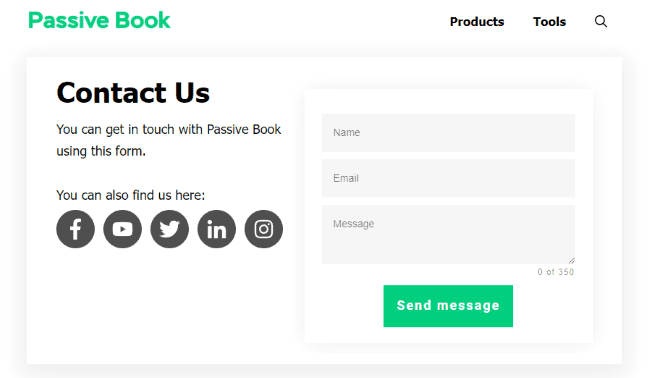
Privacy Policy
A privacy policy page is a page that tells your visitors how you collect, use, and disclose their personal information. The privacy policy page is required by law if you collect any personal information from your website visitors.
WordPress generates its privacy policy for you. But you can also use a tool like Termly to generate your own privacy policy.

Terms of Service
A terms of service page is a page that tells your visitors how they can use your website and the content that you publish on your website. The terms of service page are required by law if you allow your visitors to register for an account on your website.
Use a terms & conditions generator like Termly to create it.
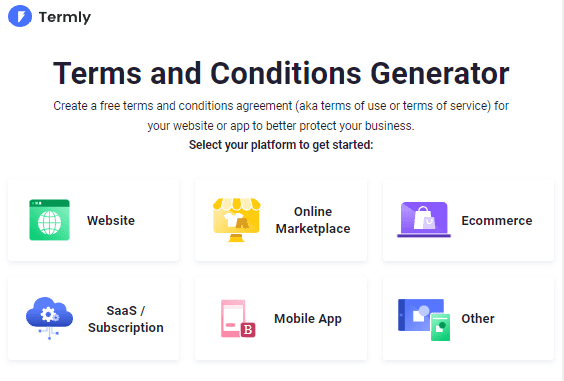
5. Write & Publish Blog Posts
Now that you have your parenting blog set up, it’s time to write and publish your first blog post. To craft the perfect blog post, check out our in-depth guide on How to Write A Blog Post. Here we will go over specific tips for a parenting blog.
1. Brainstorm Topics
You should brainstorm 100 topic ideas for your parenting blog. This will ensure that you always have content to write about in your parenting blog.
The goal is to find topics for your parenting blog that your audience is searching for in Google. The type of content you write will depend on your specific niche.
Here are a few parenting blog post ideas, you can potentially cover in your parenting blog:
- How to Posts
- List Posts
- Reviews
- Question Posts
There are a few ways to brainstorm specific content:
Look at Competitors
If you want to be a successful parenting blogger, you need to be constantly write new content. But how do you come up with ideas for your blog posts?
One way is to look at the articles your competitors are writing about. This will give you an idea of the type of content that your audience is interested in. You can also get ideas for how to improve upon the content your competitors are writing.
To find competitor blog posts, simply do a Google search for your niche keyword and take a look at the articles that come up in the search results.
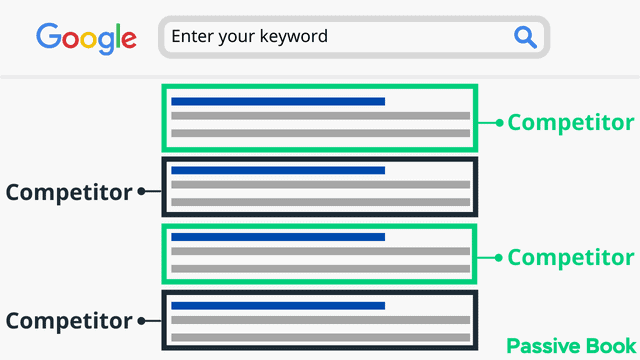
For example, if you’re in the parenting niche, you can do a Google search for “parenting tips” and take a look at the articles that come up in the search results.
Do Keyword Research
Another way to come up with ideas for your blog posts is to do keyword research. People who read your blog will find your content through Google. Keyword research is the process of identifying keywords that your target audience is searching for in Google.
To do keyword research, you can use a tool like KeywordTool.io. This tool will help you find keywords that are related to your niche topic.
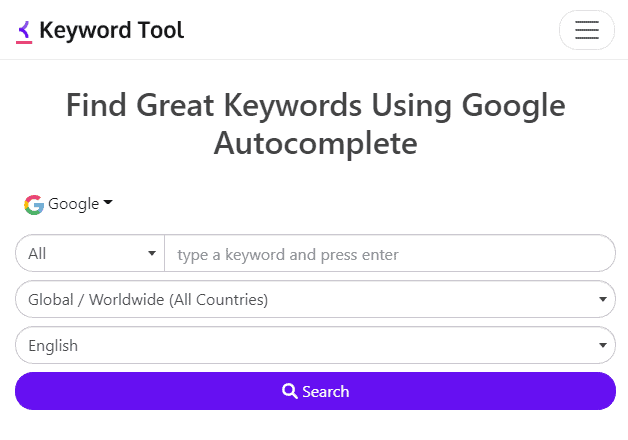
Community & Forums
If you want to find blog post topics, you can look for them in online communities and forums. This will help you identify the types of content that your audience is interested in.
You can also look at Facebook Groups, Reddit, and Quora to find topics your audience is interested in.
2. Create an Editorial Calendar
Once you have a list of ideas for your blog posts, it’s time to create an editorial calendar. This will help you plan and organize your content.
The benefits of using an editorial calendar are:
- It helps you plan and organize your content.
- It allows you to visualize your content.
- It helps you track your progress.
- It keeps you accountable.
Your editorial calendar should include the following:
- Title of blog post
- Topic of blog post
- Target keyword
- Meta description
- Publish date
Download Content Calendar Template

Steal our exclusive content calendar template. Have it delivered directly to your inbox:
You can create your editorial calendar in Google Sheets or Trello.
3. Write a Blog Post
Once you have an idea for your blog post and you’ve added it to your editorial calendar, it’s time to start writing.
Parenting Tips
Parenting Tips is a type of blog post where you share practical advice and tips on different aspects of parenting such as discipline, sleep training, and potty training.
Some examples of Parenting Tips post titles include:
- “Effective discipline techniques for toddlers”
- “Potty training 101: a guide for parents”
- “The importance of sleep training for babies”

When writing a parenting tips post, it’s important to be well-informed and well-researched. Use credible sources and provide accurate and up-to-date information. Additionally, it’s important to explain the information in a clear and easy-to-understand manner and to consider the level of knowledge of your target audience.
When writing a parenting tips post, it’s also important to be mindful of the tone and language you use and to be respectful and sensitive to the different parenting styles and philosophies. Additionally, it can be helpful to include personal anecdotes or examples to make the post more relatable and engaging.
Personal stories
Personal stories are a type of blog post where you share your own personal experiences and struggles as a parent, and how you overcame them. This can include your journey to becoming a parent, your struggles with postpartum depression, or your experience with a particular stage of parenting.
Some examples of Personal Story post titles include:
- “My journey to becoming a parent”
- “Overcoming postpartum depression”
- “The challenges of parenting a teenager”

When writing a personal story post, it’s important, to be honest and open about your experiences. Share the ups and downs of your journey and be vulnerable with your readers. Additionally, it’s important to be respectful and sensitive to others who may be going through similar struggles.
When writing a personal story post, it’s also important to be aware of the potential impact of your post and to be responsible for what you are sharing. Be respectful of any personal information that may be shared, and consider the potential consequences of sharing certain details. Additionally, it can be helpful to include tips or advice based on your experiences to help others who may be going through similar struggles.
Product Reviews
Product reviews are a type of blog post where you review and rate different baby gear, toys, or parenting books.
Some examples of product review post titles include:
- “Product review: [Brand/Product]”
- “Top [number] baby gear products”
- “Our favorite parenting books”
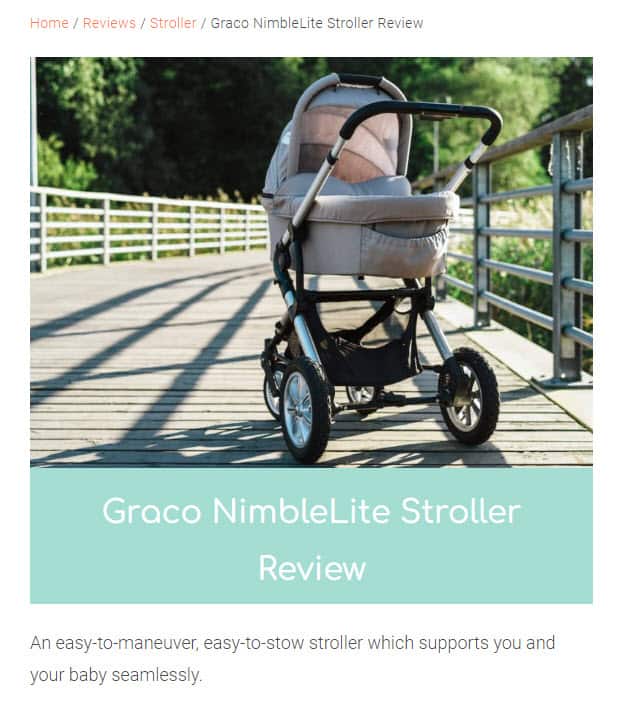
When writing a product review post, it’s important, to be honest and objective in your evaluation of the product. Consider the product’s features, quality, and overall effectiveness. Additionally, it can be helpful to include images or videos of the product to make the post more visually appealing.
When writing a product review post, it’s also important to consider your target audience and their needs. Be mindful of any specific requirements or preferences they may have, and consider the cost and availability of the product. Also, it’s important to disclose any potential conflicts of interest, such as if you received the product as a sample or if you have any financial ties to the brand.
To write a review, follow these steps:
- Choose a title for your blog post. The title should include the name of the product or service you’re reviewing.
- Write an introduction to your blog post, talking about how you came across the product or service and what problem it was supposed to solve for you. The introduction should be around 50-100 words.
- Write a detailed review of the product or service, talking about your experience with it. Be sure to include both the pros and cons of the product or service.
- Include images and videos in your review to help illustrate your points.
- Write a conclusion for your blog post, giving your final thoughts on the product or service. The conclusion should be around 50-100 words.
- Add a CTA at the end of your blog post, such as links to where readers can buy the product or service you’re reviewing or sharing your affiliate link if you’re an affiliate for that company.
How-to guides
How-to guides are a type of blog post where you provide step-by-step instructions on specific parenting topics such as how to create a routine for your child or how to plan a family vacation.
Some examples of How-to Guide post titles include:
- How to potty train your child in 5 days
- How to make homemade baby food
- How to get your child to sleep through the night
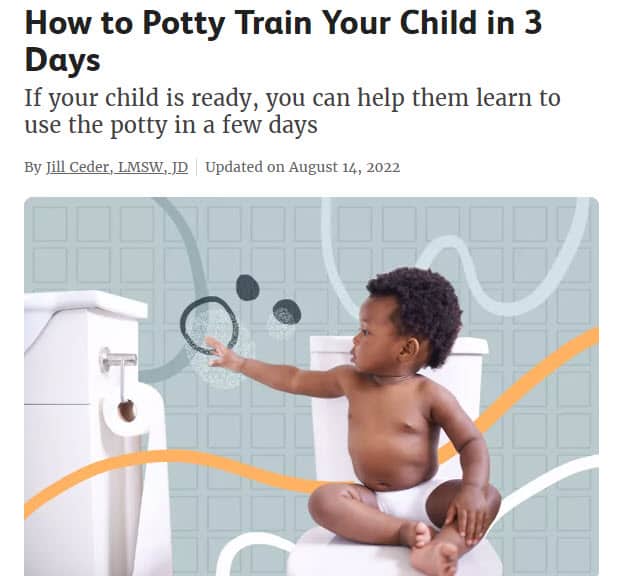
When writing a how-to guide post, it’s important to be clear, and concise, and provide detailed instructions and tips. Use images and videos to help readers understand the steps more easily. Additionally, it’s important to consider the level of knowledge of your target audience.
Consider the cost and availability of the products or resources needed. Also, it’s important to be sure that the guide is safe and appropriate to follow.
Buying guides
Buying guides are a type of blog post where you provide advice on what to look for when buying baby gear, toys, or parenting books.
Some examples of Buying Guide post titles include:
- “The ultimate guide to buying a baby carrier”
- “How to choose the right stroller for your family”
- “A parent’s guide to buying the best toys for your child”
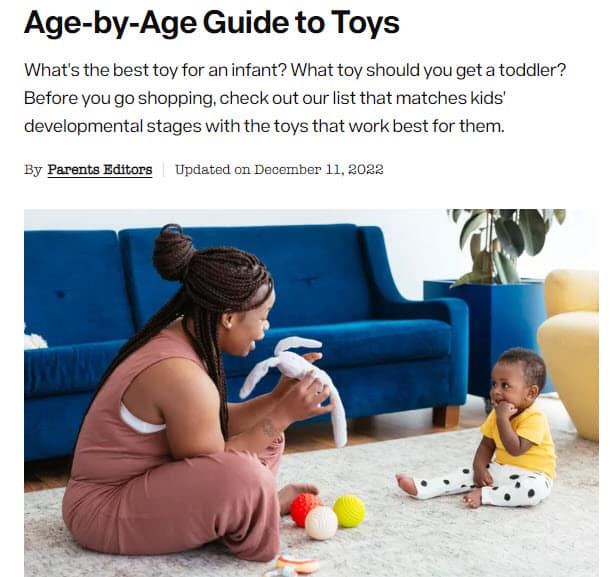
Provide detailed information on features, quality, and overall effectiveness of the items. It can be helpful to include images or videos of the products to make the post more visually appealing.
Q&A
Q&A is a type of blog post where you answer readers’ questions about parenting and child-rearing related topics.
Some examples of Q&A post titles include:
- “Answering reader questions on potty training”
- “Q&A: Sleep training expert on common misconceptions”
- “Addressing common questions about feeding babies”

When writing a Q&A post, it’s important to be thorough and detailed in your answers. Use credible sources and provide accurate and up-to-date information.
It’s also important to be aware of the target audience and their level of knowledge on the topic. Consider providing additional resources or links for further reading and research.
Writing List Posts
Another popular type of content in parenting blogs are list posts.
List posts are articles that are structured around a list of items, tips, or ideas.
Examples of list posts include:
- 10 potty training tips for parents
- 5 ways to get your child to sleep through the night
- 3 homemade baby food recipes

To write a list post, follow these steps:
- Choose a title for your blog post. The title should include the number of items in your list. Odd numbers get more clicks and shares than even numbers.
- Write an introduction talking about how reading the list post will help the listener. The introduction should be around 50-100 words.
- List down each item of your list as a sub-heading followed by a paragraph explaining it in more detail.
- Have the most interesting item on your list as the first item.
- Write a conclusion for your blog post. The conclusion should be around 50-100 words and should recap the main points of your article.
- Add a CTA at the end of your blog post, encouraging your readers to take action which can be leaving a comment, signing up for your email newsletter, or sharing your post on social media.
Writing Question Posts
Question posts are articles where you answer a question your audience has in detail. It is similar to a Q&A post but picks one question and answers it in detail.
Here are a few examples of question posts:
- Why do children like stories?
- What are the side effects of kids playing video games?
- When will a child start teething?

To write a question post, follow these steps:
- Choose a title for your blog post that includes the question you’ll be answering in your article.
- Write an introduction to your blog post, talking about how you came across the question and why you decided to answer it. The introduction should be around 50-100 words.
- Answer the question concisely in the first paragraph so that the reader immediately gets what they came there for.
- Answer the question in more detail in the following paragraphs, providing as much information as possible.
- Write a conclusion for your blog post, giving your final thoughts on the topic. The conclusion should be around 50-100 words.
- Add a CTA at the end of your blog post, such as encouraging your readers to leave a comment with their own thoughts on the topic or share your article on social media.
Outsource Writing
If you don’t have time to write content for your parenting blog, or if you simply don’t enjoy writing, you can outsource the writing to a professional writer.
There are a few different ways to find writers for your blog:
- Fiverr is a freelancing platform where you can find writers starting at $5 per article.
- Upwork is another freelancing platform where you can find writers starting at around $10-$15 per article.

When hiring a writer, be sure to:
- Read through their samples to get an idea of their writing style.
- Check their reviews to see what other clients have said about them.
- Give them a trial run by hiring them for one article first before giving them more work.
4. Add Images
Make sure to add images to your blog posts to break up the text and make your articles more visually appealing.
When adding images to your parenting blog, make sure you:
- Use high-quality images that are relevant to your article.
- Optimize your images for SEO by including keywords in the file name and alt text.
- Use images that are a reasonable size so that they don’t slow down your site.
- Compress your image so that the file size is reduced.
- Use jpeg format for photos and png for graphics.
The best photos you can use in your parenting blog are the ones you take yourself. You can use your smartphone camera to get started and invest in a DSLR camera as your parenting blog grows.
If you cannot or don’t want to take your own photos, then you can use stock photos in your parenting blog.
There are a few sites from where you can get stock photos from:
Free Options: Pixabay, Pexels, Upsplash
Paid Options: Deposit Photos, Shutterstock, iStock, Getty Images, 123rf.
You can edit and create images for free using Canva. It is a free online design platform that you can use to create images for your parenting blog.
If you want to use high-quality images in your parenting blog, then you should upgrade to Canva Pro. The free version of Canva has a limited library of stock images, but the Pro version has a much larger library.
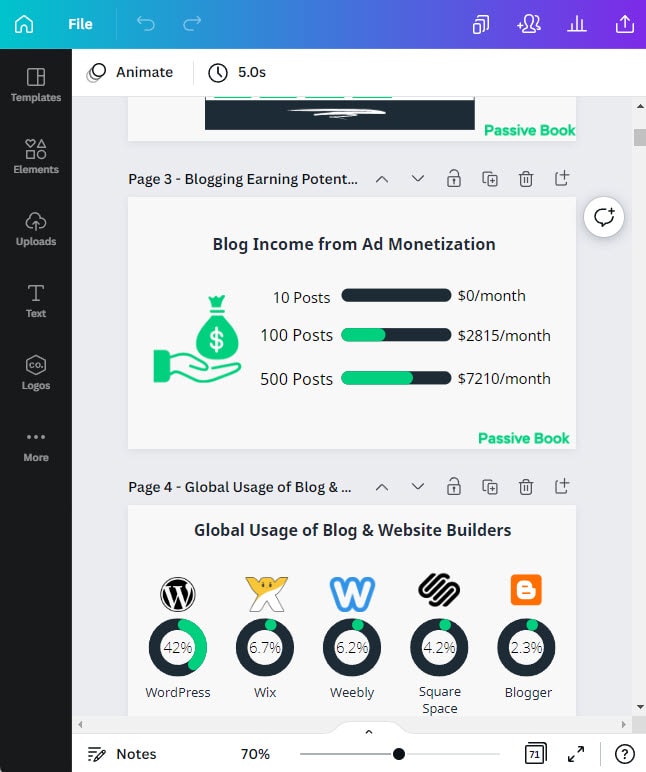
6. Promote Your Parenting Blog
The only way you will grow your blog is by promoting it. There are a few ways you can promote your parenting blog so that it gets more blog traffic.
Search Engine Optimization (SEO)
SEO is the process of optimizing your website so that it appears higher in search engine results pages (SERPs).
There are a few things you can do to optimize your site for SEO:
- Research keywords and include them in your blog posts and titles
- Use keywords in the introduction, body, and sub-headings of your articles.
- Use images with relevant keywords in the file name and alt text.
Many factors go into SEO, and it can be a bit confusing to figure out where to start. You can master the more advanced SEO tactics by checking out our SEO Resources.
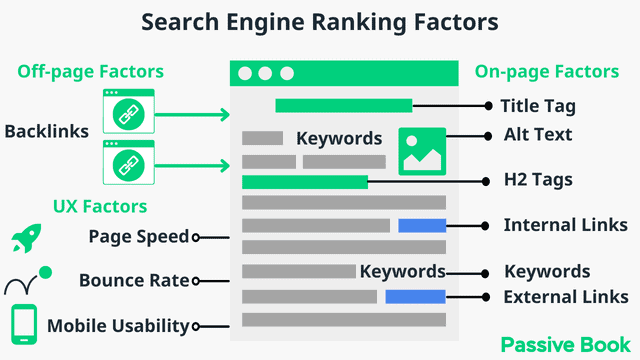
You can ensure you get the basics of SEO right, by completing the recommendations given by the RankMath plugin.
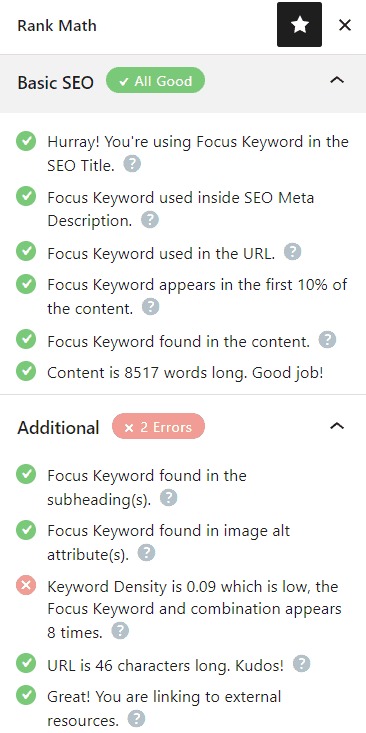
Email Marketing
Email marketing is a great way to promote your parenting blog and build a relationship with your readers.
Building an email list allows you to send your readers updates about your latest blog posts, as well as other exclusive content that they can’t find on your blog.
You can encourage people to sign up for your email list by:
- Creating a pop-up or sign-up form on your blog
- Adding a sign-up form to your blog’s sidebar
- Creating a landing page specifically for email sign-ups
You can use then connect it to an email marketing service like ActiveCampaign to create and send emails to your list.
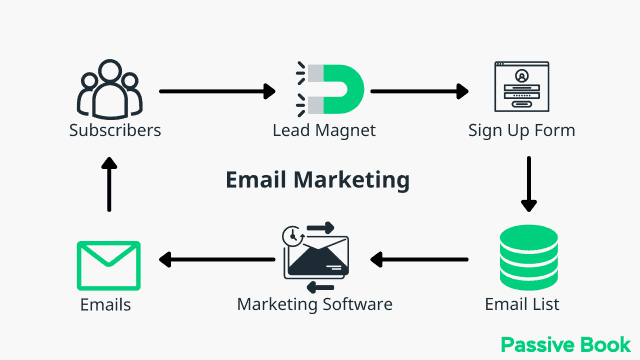
You can use the Thrive Leads plugin to build opt-in forms to collect email addresses. You can then connect the opt-in form to an email marketing service like Active Campaign to send out the emails.
Check out our Email Marketing resources to learn more.
Social Media Marketing
Social media marketing is the process of using social media platforms to promote and grow your business.
It’s a great way to connect with potential and current customers, as well as build relationships with other businesses in your industry.
The best social media platform for promoting your parenting blog will depend on your target audience.
If you’re targeting millennial moms, then you should focus on Pinterest and Instagram. If you’re targeting dads, then you should focus on Twitter.
You can use social media to promote your blog by:
- Posting links to your latest blog post
- Creating shareable images with quotes from your blog posts
- Hosting social media chats
- Collaborating with other bloggers in your niche
Guest blogging
Guest blogging is when you write a blog post for another website in your industry.
It’s a great way to get your name and your blog in front of a new audience.
When guest blogging, make sure you:
- Choose a website that is relevant to your niche.
- Write a high-quality blog post that will be interesting and valuable to their audience.
- Include 1-2 links back to your website.
- Share your blog post on your social media channels.
You can link back to your blog from the guest post. You can also promote your blog from the author’s bio.

7. Monetize & Make Money
There are a few different ways you can monetize your blog and earn money from your parenting blog:
Advertising
One way you can make money from your parenting blog is by selling ad space on your website. Advertisers will pay you to display their ads on your website.
The best way to get started is to sign up to an ad network. They will give you an ad code that you can place on your parenting blog. You will get paid when someone views or clicks on your ad.
To start advertising on your blog, you can sign up for an ad network like Ezoic (they pay more than Google Adsense). When your blog starts getting more than 100,000 page views a month you can monetize with Adthrive.
| Ad Network | Earnings Per 1K Impressions (EPM) | Monthly Traffic Requirement |
|---|---|---|
| Ad Thrive | $13 | 100,000 |
| Ezoic | $3 | 10,000 |
| Media.net | $1 | – |
| Google Adsense | $1 | – |
Affiliate Marketing
Affiliate marketing is when you recommend a product or service to your readers and get paid a commission if they purchase it.
For example, if you have a blog post about the best strollers for new moms, you could include an affiliate link to Amazon for the strollers that you recommend.
If someone clicks on your link and purchases the stroller, you will get a commission.
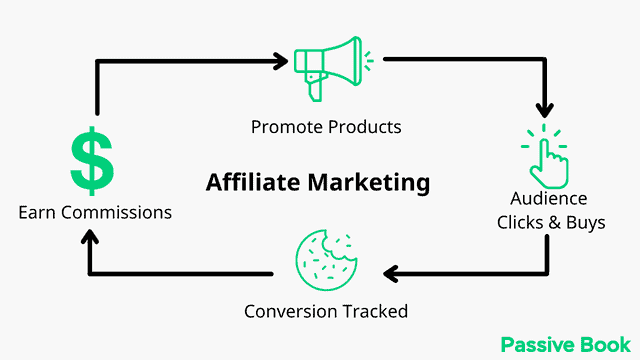
You can find affiliate programs for products and services by:
- Searching for “product/service name + affiliate program”
- Checking out the websites of companies that sell products or services that are relevant to your niche and see if they have an affiliate program.
- Look at what products your competitors are promoting in their blogs.
Digital Products
If you have expertise in a particular area, you can create and sell digital products on your parenting blog. This could be in the form of an e-book, video course, or audio course. Creating and selling digital products is a great way to make passive income from your parenting blog.
You can use Teachable if you want to sell video courses. Your students will have a dedicated course members area and a community system to ask questions and interact with each other. If you only want to sell eBooks, you can use SendOwl which lets you sell your digital products and eBooks for free.

Sell Services
Another way to make money from your parenting blog is by selling services. This could be in the form of coaching, consulting, or webinars. Services are a great way to make money from your parenting blog because you can charge a premium for them.
To get started with selling services on your parenting blog, you can create a sales page and promote it in your blog.
Physical Products
If you have a physical product that is relevant to your niche, you can sell it on your parenting blog. This could be in the form of a baby carrier, nursing cover, or mommy apparel.
To get started with selling physical products on your parenting blog, you can use an ecommerce platform like WooCommerce or Shopify and add the link to your shop page on your parenting blog.
Sponsored Post
Making money with sponsored posts in a parenting blog can be done by leveraging your blog’s reach and audience. To get started, you will need to create content that appeals to your target audience and build up a following on social media. Once you have established yourself as an authority in the parenting niche, companies may reach out to you for sponsored posts.
You can also actively seek out sponsorships from companies that are relevant to your blog’s subject matter. Reach out to brands and businesses in the parenting industry that offer products or services related to what your blog is about. Offer them the opportunity to advertise on your blog in exchange for a fee. You may also be able to negotiate additional perks such as free products or discounts for your readers.
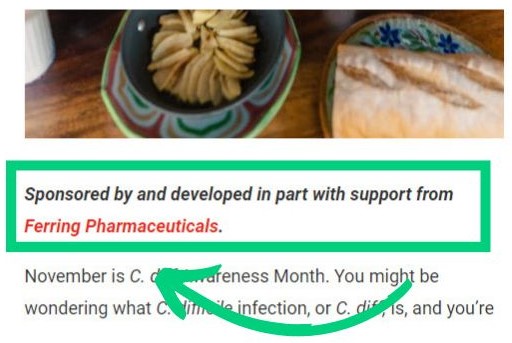
Finally, make sure that any sponsored content you post is clearly marked as such so that it does not appear deceptive or misleading to readers.
FAQ
What should I blog about as a mom?
There are a lot of different things you can blog about as a mom. You can blog about your parenting journey, share tips and advice, review products, or even sell physical or digital products.
How can I make money from my parenting blog?
There are a few different ways you can make money from your parenting blog. You can use advertising, affiliate marketing, sell physical or digital products, or offer services.
What Next?
It’s no secret that parenting is a full-time job.
Between dealing with tantrums in public, trying to get kids to eat their vegetables, and reading one more bedtime story, it seems like there’s never enough time in the day.
The wisdom you share with other parents in your parenting blog might be just what an overwhelmed parent needs to get through their day.
We hope this guide showed you how to start a parenting blog.
If you have any questions as you set up your new blog, leave a comment below so we can help you out.
Have you started your parenting blog yet? What type of parenting blog are you going to start? Let us know in the comments.
Share this post with your friends & followers:
